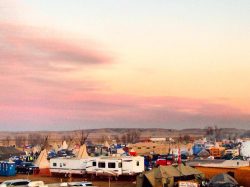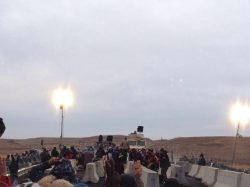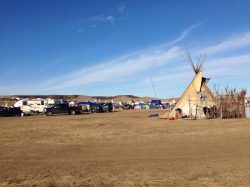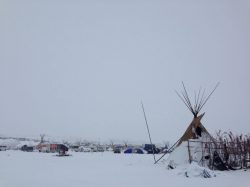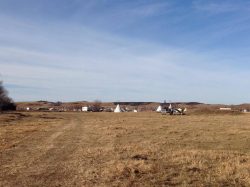
The sun came out tomorrow for protesters at Standing Rock.
After months of major, peaceful protests by indigenous peoples against the construction of the Dakota Access Pipeline (DAPL) through the Standing Rock Sioux reservation water supply, the pipeline will been diverted. What does this mean, and what are conditions like in and around Standing Rock? Senior staffer Sarah Dahl recently caught up with Barnard sophomore Jessie Lee Rubin who, along with fellow students Yasmeen Abdel Majeed, Maggie Anderson, and Rachel Culp, just got back from the camp. For more information, here is a statement from the Standing Rock Sioux Tribe.
How did you get there? We flew very early on Thanksgiving Day out of Newark to Bismarck (with really cheap student tickets) and then got a ride to the camp. We were there for about six days.
What made you decide to go? We really only wanted to go if we felt like we could give more by going than we were taking. Because of this, we raised about $800 (through Facebook statuses) before we went. [All this money went to the camp; the students paid for their plane tickets and borrowed their own supplies]. We were able to order a good number of supplies (including a windmill) from the organizers’ wish list, in addition to the volunteering we did once we got there.
What were living conditions like at the camp? We stayed in a tent, surrounded by thousands of other supporters. (I heard that at its peak, there were about 10,000 people there!) The first night we spent at Sacred Stone camp, and the rest of the time we spent at Oceti Sakowin. We had to bring multiple sleeping bags each because it was so cold, we would wake up in the morning with our sleeping bags covered in frost! No joke–I wore five pairs of socks to bed every night. We mostly brought our own food, even though the camps have communal mess halls, because we didn’t want to use up resources if we didn’t have to. While we were there, we attended a great talk on decolonization; the speaker argued that white allies’ entitlement to resources such as food and firewood at Standing Rock was a form of colonial violence. I tried to organize my stay around avoiding, if not combating, this dynamic as much as I could–using as few of their resources as I possible, and centering my trip on helping in whatever way was requested of me.
- The sun came out tomorrow for protestors at Standing Rock.
- Photos of the camp.
What kinds of people did you meet? What made them come to protest? We met so many interesting people! While the purpose of the gathering was to protest the pipeline, that goal contained within it several different, if overlapping, motivations. For instance, both environmental activists and those seeking to support indigenous rights were there in high numbers. We talked to indigenous folk from all over the country who came to support the protest. There were also many white allies who came to the camp. Unfortunately, some of the people we met failed to privilege indigenous sovereignty, breaking rules laid out in the orientation (by smoking weed, for example), and treating their trip like a vacation. I really want to stress, though, that the overwhelming majority of people we met were extremely inspiring, and used their abilities to put hard work into construction, cooking, art, etc. A lot of people could only stay for a week like us, but there were also a lot of people who stayed for months on end. For the most part, people were really good at making themselves useful for the time they could stay.
What did you participate in? For the most part, I volunteered at the camp, sorting donations or trash, or helping out in the kitchen. After the army corps of engineers sent an eviction notice to the camp, there was a decline of direct actions for a day or two while the water protectors took time to reflect and strategize. I did participate in a women-led silent march to the frontlines. Once we got to the bridge, a group of powerful, brave indigenous women boldly and peacefully held a ceremony in front of hundreds of allies, despite the large presence of police fully decked out in weapons and riot gear (the same police who had used water cannons, rubber bullets, and pepper spray on peaceful protesters a couple of days before). The action was strikingly powerful–the indigenous women worked to reclaim the land as their own, and as allies, we were able to silently and forcefully support this.
What was the police/national guard/authority presence like? There was no police presence on the camp grounds, but on the bridge there was a large presence of police. I never came in direct contact with them (and most people at Standing Rock don’t have to!). I did witness a sharp exchange between the leader of the march and the police, who conceded to us in terms of our standing on the bridge, but only allowed for the six indigenous women participating in the ceremony to come all the way forward.
Did the trip change you? Do you feel different being back at Barnard? In a society that stresses individual property, ambition, and social movement, collective action certainly has a lasting effect, and I am grateful for the opportunity to evolve presented [by being in the camp]. I left Standing Rock thinking deeply about four points stressed at the orientation:
1.The protest should be indigenous-centered. We came to Standing Rock from a place of serious privilege. It was very important to avoid any kind of “white-savior” complex, as the whole point of the protest was that indigenous voices had been silenced.
2. Leave a legacy. Showing respect for the community we were supporting did not mean we had no way to leave a mark. I asked myself continuously, “How would I like to be remembered here? For what?” Ultimately, I felt as though my contributions should not be about my own self-gratification, but rather should benefit the community who would remain after we left.
3. Be of use. Largely, this meant asking what would be helpful, and not coming in with our own game plan. I tried hard to be useful while I was there, and not act like I had arrived knowing what was best.
4. Bring it home. In some ways, this is the most important: we can’t act as though Standing Rock is some sort of remote island; the endangerment presented by the pipeline argues powerfully to the contrary. Now that I am back at Barnard, I have to focus energies on organizing on campus!
Is there a message you’d like to bring back from protesters? What can other students do to help? Are any campus protests or supply fundraisers being organized? It is important not to let our guard down too quickly and assume the struggle is over. We must keep reading about new plans for the pipeline, and remember that relocating it, rather than stopping it, is a partial solution at best. There is much that can be done to both continue to fight and show solidarity with those most affected by the pipeline. We will be asked to protest banks that fund the pipeline (one of these, Citibank, is just a couple of blocks away from campus). Because of the huge number of resources used in the struggle to fend off the pipeline, donations of money or materials from the protest’s wishlists are still greatly appreciated
Are you happy with the announcement to divert the pipeline? Of course, I am happy–but it is important that happiness does not make us complacent. This is not the end of the fight. In fact, many people involved with the protest are calling the announcement a “delay tactic,” which could end up with a number of concrete results, but above all means that that we have to watch closely and continue to offer our support. Again, participating in an inspiring collective action, and then hearing an announcement like the one about the pipeline diversion is quite gratifying, but while we can and should celebrate victories along the way, we can’t let our attention slip or fall for an implication that the struggle is over. [You can sign up to receive emails from the North American Indigenous Peoples Caucus, or donate money to Stand With Standing Rock].
Do you think this decision implies good things regarding the future of indigenous peoples’ rights, or the power of people protesting? Yes–the announcement about diverting the pipeline is a clear response to people’s protests, and shows that coming together in collective action truly is powerful. (This is one of the most important lessons of American history, as many examples of organizing for social justice have taught us.) The reaction of the Army Corps of Engineers is a confirmation of how important it still is to indicate that “we shall not be moved.”
Photos courtesy of Jessie Lee Rubin.


 0 Comments
0 Comments